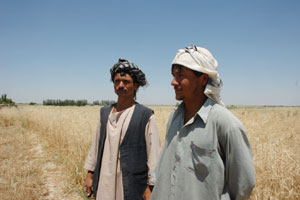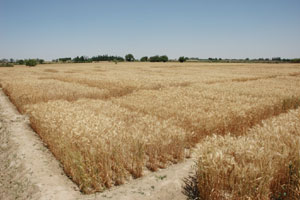CIMMYT E-News, vol 4 no. 7, July 2007
Somewhere between the romance of the Silk Road and the land mines, CIMMYT works as part of the team that is rebuilding the shattered agriculture of Afghanistan.
It looked like a scene from a Tolstoy novel—four, weathered men with hand sickles working under the blazing, noonday sun to harvest a field of wheat. No combine harvester here, just the power of their backs and arms and hands. But Tolstoy wrote 140 years ago. This scene is today, 2007, in northern Afghanistan near the city of Mazur i Sharif, not far from the Uzbekistan border. Wheat is the most important food crop in this embattled country where 85% of the population depends on agriculture to sustain life. Yet wheat yields on its worn soils are notoriously low—only 2-2.5 tons per hectare, even on irrigated land. Unlike the republics of the former Soviet Union to the north, land holdings in this part of Afghanistan are small and do not lend themselves to large scale mechanization. You can understand what that really means when you talk to the farmers themselves.
 Faizal Ahmad and his brother Hayatt Mohammad are sharecroppers on this 8 hectare parcel of land. They pay the landowner a share and the crew that is harvesting gets a share, and with what is left, they try to feed their families, maybe sell a little.
Faizal Ahmad and his brother Hayatt Mohammad are sharecroppers on this 8 hectare parcel of land. They pay the landowner a share and the crew that is harvesting gets a share, and with what is left, they try to feed their families, maybe sell a little.
“From the sharecropping we just survive,” Faizal says. “We are not going to get rich and we won’t make very much money.”
The crew working the field is part of a community harvesting system. They are paid in wheat seed rather than cash and get two meals for the day’s work. They too keep some land for wheat. In Afghanistan, no matter what else you grow, wheat comes first for family food security.
During the Taliban and warlord times, the brothers fled with their families to Pakistan but returned with the installation of the new government in 2004. And even though farming this irrigated land year round is tough, Hayatt, who is married with a son and daughter, says they are making a go of it. “Life is difficult, and we are struggling and hope things could improve.”
They are growing an improved but older wheat variety called Zardana Kunduzi which they get through an informal farmer-to-farmer seed system. Unhappily, their land is infested with wild oats. The weed reduces the wheat harvest, both by competing for space and by taking nutrients. No matter what the farmers try, the weeds come back every season. Of course herbicides are not an option for people with so little.
This is the milieu in which CIMMYT finds itself in Afghanistan—older varieties that are more susceptible to pests and diseases, a seed system that needs rebuilding from the ground up and agronomic practices that need improvement to give farmers like Faizal and Hayatt a real chance on the little land they have.
In partnership with the Ministry of Agriculture Irrigation and Livestock of Afghanistan (MAIL), CIMMYT has been testing potentially better wheats for conditions specific to different parts of the country. Already a new variety of durum wheat is available and not far from where Faizel, Hayatt and the crew are working another farmer is growing the durum for seed. His field is healthy and the crop looks excellent. He has been contracted by one of the new seed production companies that are part of a project sponsored by the Food and Agriculture Organization of the United Nations (FAO). Making that seed system sustainable, while providing seed at an affordable price is a great challenge.
The new agriculture master plan for Afghanistan prepared by MAIL praises CIMMYT for “considerable training of Afghans (that) sets a desirable standard.” In fact more than 50 Afghan researchers have had training at CIMMYT and more than 70 technicians, farmers and NGO workers have taken technical training at workshops in Afghanistan. Much of CIMMYT’s work in Afghanistan is supported by Australia through both the Australian overseas aid program, AusAID and the Australian Council for International Agricultural Research (ACIAR).
 At least three more varieties developed from materials originally from CIMMYT (some via the winter wheat breeding program in Turkey) are in the new varietal release pipeline that Afghanistan has implemented. They have already demonstrated in farmers’ fields that they are well-suited to local conditions and can provide more wheat per hectare than farmers currently harvest with yields in on-farm trials of almost 5 tons per hectare, double what most farmers get. These wheats can be seen in trials at the Dehdadi Research Farm near Mazur, almost within sight of the sharecropping brothers.
At least three more varieties developed from materials originally from CIMMYT (some via the winter wheat breeding program in Turkey) are in the new varietal release pipeline that Afghanistan has implemented. They have already demonstrated in farmers’ fields that they are well-suited to local conditions and can provide more wheat per hectare than farmers currently harvest with yields in on-farm trials of almost 5 tons per hectare, double what most farmers get. These wheats can be seen in trials at the Dehdadi Research Farm near Mazur, almost within sight of the sharecropping brothers.
Nevertheless, Mahmoud Osmanzai, the CIMMYT country coordinator in Afghanistan says there are still real challenges to close the gap between the yields that can be achieved in well-managed demonstration plots and the yields poor sharecroppers like Faizel and Hayatt actually achieve. “We have good varieties that will make good bread,” he says. “Now we have to find a way that let’s resource-poor farmers get the most from them.”
For the sharecropping brothers, a little more income from their small piece of borrowed land could go a long way. “Yes if we could save, we could have a second business.” says Faizal. “We would probably get a shop as well or buy a car, run a taxi, build something to produce more.”
For more information: Mahmood Osmanzai, Afghanistan country coordinator (m.osmanzai@cgiar.org)
 Climate adaptation and mitigation
Climate adaptation and mitigation 
